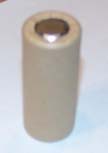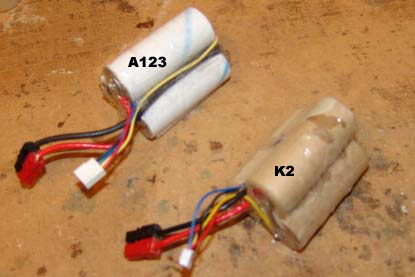|
By Ken Myers Original posting date: June 23, 2008 Updated July 23, 2008
K2 Energy provides a Lithium Iron Phosphate type cell. www.peakbattery.com Steve Hill, of Robotic Power Solutions (AKA www.battlepack.com), provided some 26650 2500mAh cells (non-CID version) for me to compare directly against the 26650 A123 Systems, Inc. 2300mAh cells. The K2 Energy cells are described as; LFP26650P Hi Power Rechargeable 3.2V 2500mAh. There is a thread on RC Groups about these cells. Everydayflyer (Charles) is also testing them and has reported his results in the thread. Here is what K2 Energy says about their 26650 cell:
It is important to note that suppliers can claim whatever they want about their cells. So far, Everydayflyer, using a CellPro 10S has found the internal impedance for the individual cells in a 4S pack to be;
For comparison, here are the numbers he got from a 4S A123 Systems, Inc. 26650 2300mAh pack
K2 diameter 27mm, length 65.1mm A123 diameter 26.5mm, length 65.6mm K2 individual cell weights with tan cardboard-like sleeve: (I have four cells.) Cell 1 82.7g Cell 2 82.2g Cell 3 82.8g Cell 4 82.8g Resting voltages as delivered: Cell 1 3.28v Cell 2 3.28v Cell 3 3.28v Cell 4 3.27v Note: The button end is positive on the K2 Energy cells, which is the reverse of the 26650 cell from A123 Systems, Inc.
Cells #1, #2, and #3 were made into a pack using 2 APP connectors, power leads, node/balance leads, tape and hook and loop fastener strips. Everything was done to duplicate, as closely as possible, the A123 pack I've been using.
The new K2 Energy pack was first charged at 2.5 amps (1C) using an unmodified AF109 charger with termination done manually with the resting cell voltages being 3.732, 3.738, 3.719 about an hour and a half after the initial charge. The pack was discharge using the AF 109. The pack was then charged at 5 amps (2C) and 2.526AH was returned to the pack in 32 minutes, again terminating manually. The pack was discharged using the AF 109. The pack was then charged at 7.5 amps (3C) in 21 minutes with 2.492Ah returned to the pack. The pack sat overnight. In the morning, I was very surprised to see the Cellmeter-8 read all three cells' voltages exactly the same at 3.334v!
|
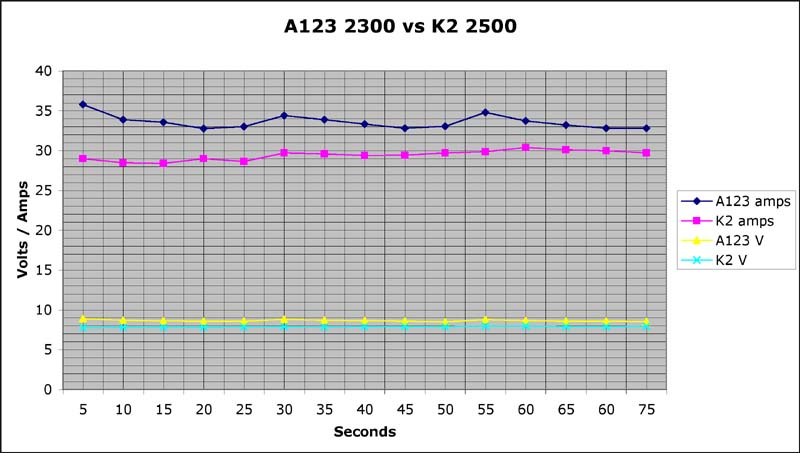
| Averages for 5 through 75 seconds:
A123: 8.62v, 33.58 amps, 8628 RPM, Watts in 289.60 K2: 7.88v, 29.41 amps, 7978 RPM, Watts in 231.67 In my article "Effects of Temperature On the Battery", I noted that battery temperature effects the performance of the battery. I decided to run the second test starting 15 seconds into the motor run to allow each battery a chance to heat up under load. |
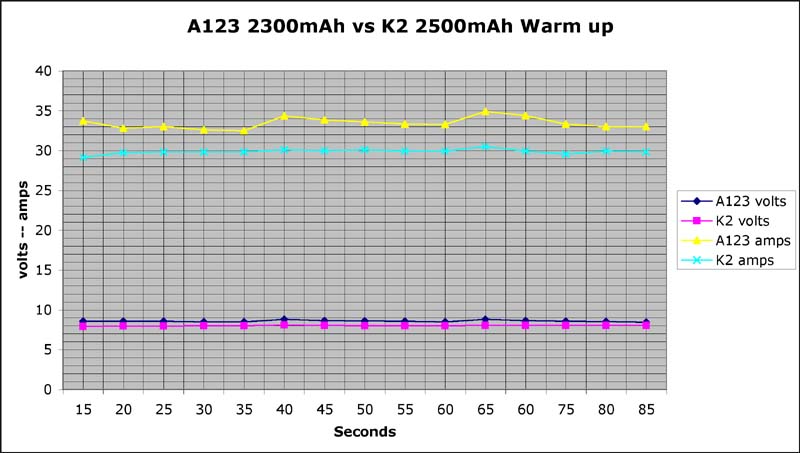
| Averages for 15 through 85 seconds:
A123: 8.57v, 33.43 amps, 8558 RPM, Watts in 286.64 K2: 8.10v, 29.87amps, 8092 RPM, Watts in 239.23 I decided to see if I could get the performance up for the K2 cells. For a plane that flies on the wing, like the Son of Swallow, pitch speed is a good indicator of relative performance. I compared the data that I had gathered with the Master Airscrew 10x7 standard wood prop for the A123 pack and K2 pack. Test two indicated a pitch speed of 56.7 mph for the A123 pack and 53.6 mph for the K2 pack.
|
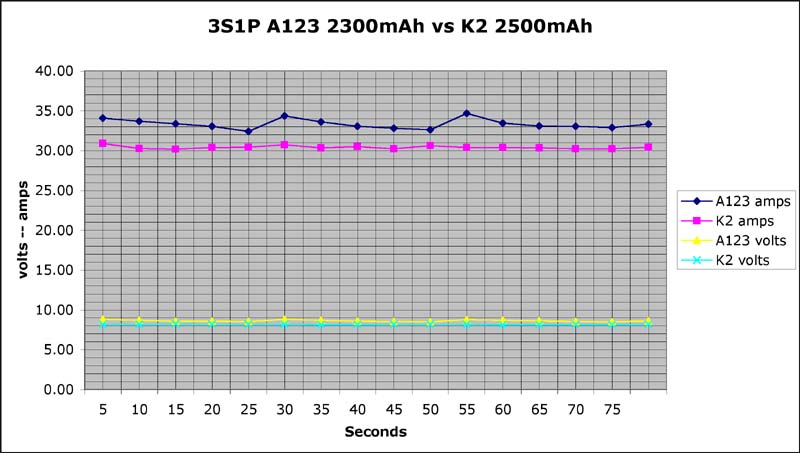
| Averages for 5 through 75 seconds:
A123: 8.61v, 33.33 amps, 8602 RPM, Watts in 286.88 K2: 8.14v, 30.39 amps, 8216 RPM, Watts in 247.50 These numbers indicated that the K2 pack was improving with use.
I do not have any onboard data gathering system. Flight-testing was done at the Skymasters' Electric Fly on June 14. It was a beautiful, sunny day with the temperature in the high 70-degee F range. The wind was about 10 mph. I first flew the Son of Swallow using the A123 pack to "get the feel and performance" of the plane fresh in my mind. After the initial flight with the A123 pack, I landed and immediately changed to the K2 pack. I did not change the prop at this time. While flying with the K2 pack I immediately noted that it required a higher throttle setting in level flight to feel the same and was just a little bit off of the performance of the A123 pack in the vertical, yet it was still good, just not quite as good.
The following Monday, I did a couple more static tests. Test 4 used the A123 pack that was charged on Saturday at the meet but never flown and the K2 pack that had been charged earlier Monday morning. The load was the 10x7 prop that I had used for all my previous testing. |
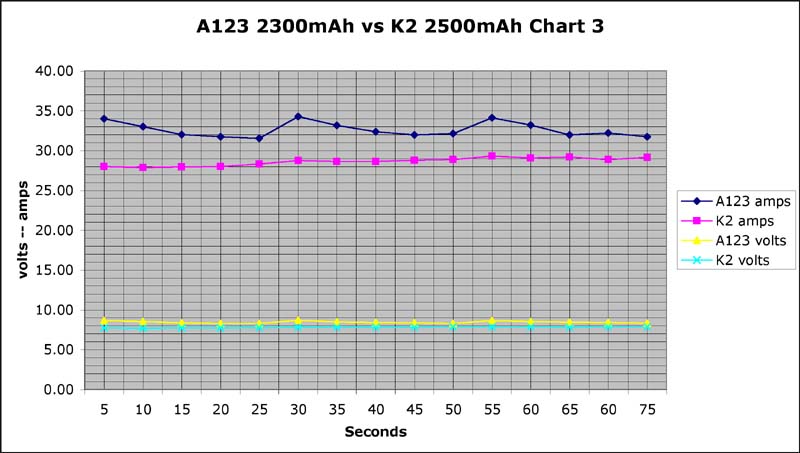
| Averages for 5 through 75 seconds:
A123: 8.43v, 32.62 amps, 8458 RPM, Watts in 275.21 K2: 7.79v, 28.62 amps, 7904 RPM, Watts in 222.89 For the next test I used the 10x7 with the A123 pack and the 10x8 with the K2 pack. Remembering that both the A123 pack and K2 pack "put out more" when warm, I tested them with the packs "hot off the charger." |
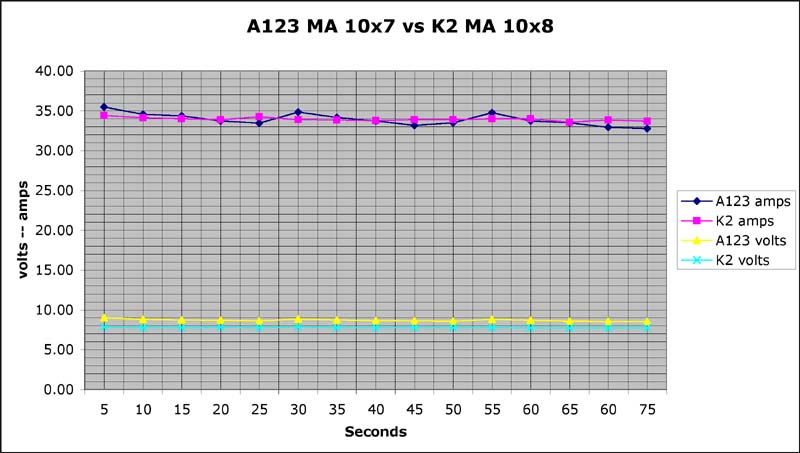
| Averages for 5 through 75 seconds:
A123: 8.68v, 33.90 amps, 8672 RPM, Watts in 294.20 K2: 7.77v, 33.92 amps, 7620 RPM, Watts in 263.50 Using the data from tests 3 and 5, I graphed the relative pitch speeds. |
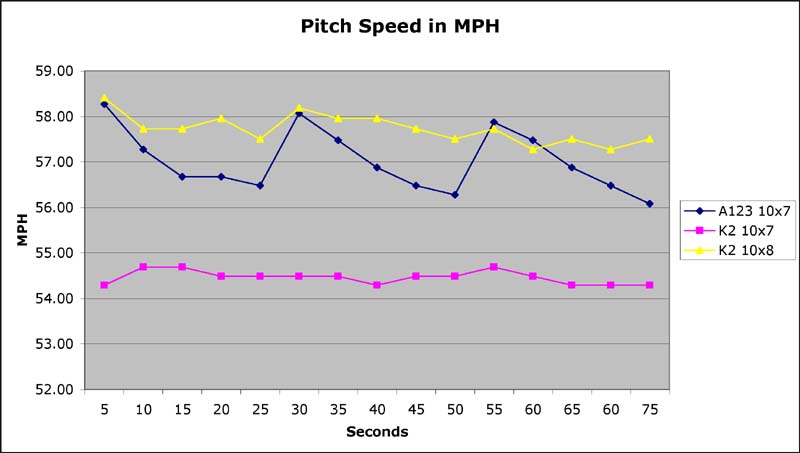
| I am continuing to fly the SOS using the K2 3S1P pack and Master Airscrew10x8 standard wood prop to check the life of the K2 cells. I have decided to charge the K2 for the rest of its life at 7.5 amps, as waiting longer than 20 minutes is "just too long", when at the field! This should provide a good "torture test" for them as well.
On the 17th of June I did a couple of discharge tests to try and establish a baseline capacity for the pack. Unfortunately, I do not have a CBA discharger. I first used my SR Batteries charger and discharged to 7 volts at a 1-amp discharge rate, as high as the unit will go. I found the results of the test, not the cells' performance, unsatisfactory with the capacity of 2224mAh and the bounce back resting voltages of the cells, after the load was removed, were 2.795, 2.616, 2.652. Next I charged the pack again and used the unmodified AF 109 charger to discharge the pack. The AF 109 uses a 1.25-amp rate, and I was surprised to find that it took the pack down to 7.07 volts, almost the same as the SR charger. It showed 2405mAh taken from the pack and the bounce back resting voltages were 2.791, 2.668 and 2.658, which was very similar to what I found using the SR charger. At this time I am not satisfied with the tests I'm using for capacity, but have recorded the results here so that I have a record of what I've seen. 06/21/08 Flying Update
06/23/08 Balance Update
06/25/08 Flying Update
06/28/08 Update - testing done on 06/27/08
|
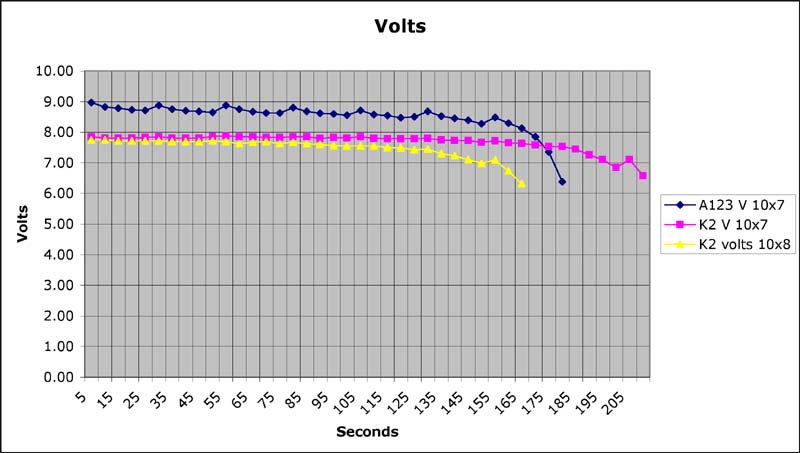
| I have not previously shown RPM, because it does not present well with the other data, so here is a graph of the RPM, for those who may be curious. The RPM obviously parallels the volts. |
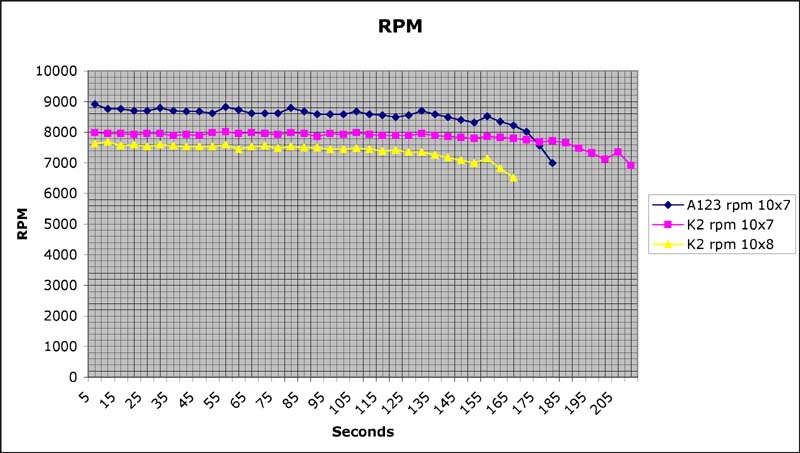
| I had noted earlier that both packs fly the Son of Swallow for 6 minutes of very aerobatic flight when the MA 10x7 wood is used with the A123 pack and the MA 10x8 wood is used with K2 pack.
The K2 pack with the MA 10x8 wood averages 32.24 amps for the 150 seconds, while the A123 pack averages 33.45 amps for 150 seconds. I noted in my first flight report that I did not care for the way the plane flew with the K2 pack and MA 10x7 prop. The reason for that can be seen in the following graph that shows the Watts in. |
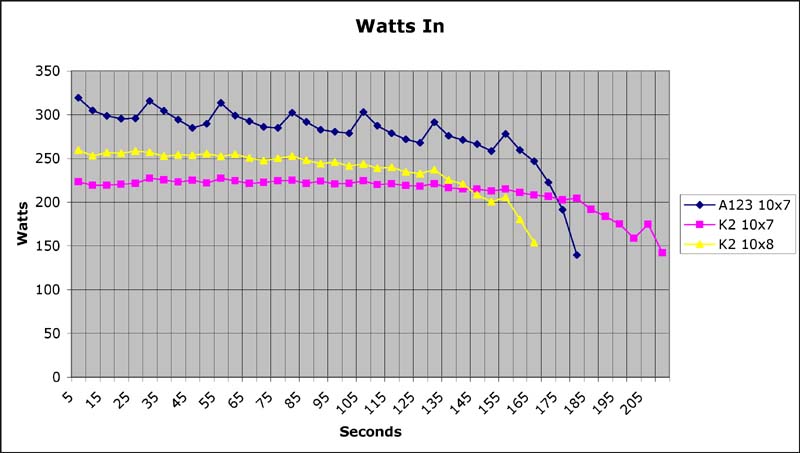
| Based on Watts in per pound, it looks like the A123 pack with the 10x7 should be far superior to the K2 pack with the 10x8, but flight testing has proven this NOT to be the case! Why? Pitch Speed. Here is a graph showing the pitch speeds. |
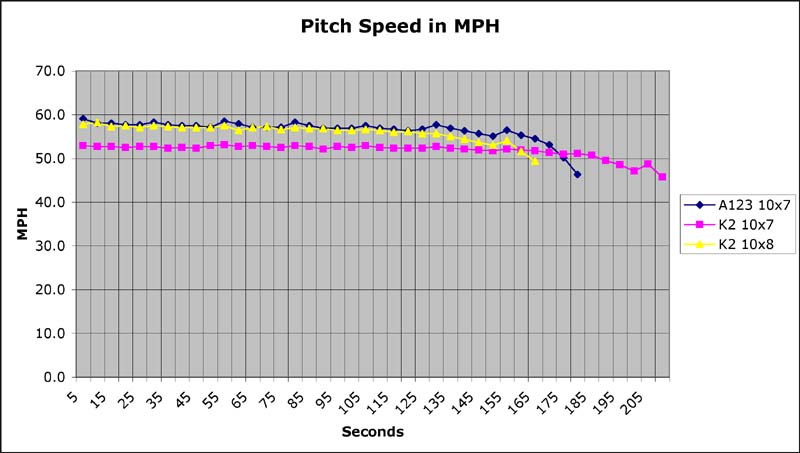
| The preceding two graphs, and my flight experiences, cleary demonstrate that, for planes that "fly on the wing" and that are "relatively clean", the pitch speed, when used in the ratio of pitch speed to stall speed, can even override the watts in per pound rule of thumb.
The Son of Swallow has a pitch speed to stall speed ratio of 4.09:1 when using the A123 pack with the 10x7 prop, 4.15:1 when using the K2 pack with the 10x8 prop, and 3.73:1 when using the K2 pack with the 10x7 prop. I honestly cannot perceive any difference in the flyability, performance or duration of the Son of Swallow whether I am flying the K2 pack with the 10x8 or the A123 pack with the 10x7. The next graph is similar to ones that I presented earlier and shows the volts and amps, but this time all the way to the 6v LVC. |
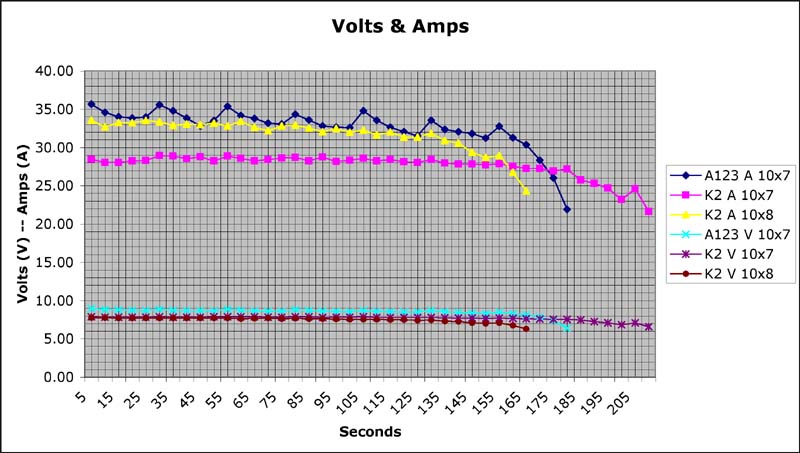
| Finally, I measured the resting voltages for the two packs approximately 18 hours after they were depleted in the tests.
K2 - 3.004v, 3.028v, 2.983v A123 - 2.947v, 2.990v, 2.944v Note: The following flight tests were completed using the K2 Energy pack with the CC Phoenix 45 at low timing, using the Hyperion (mislabeled) Z3019-10 and the Master Airscrew 10x8 standard wood prop. 07/04/08 Flying Update
07/05/08 Flying Update
07/06/08 Flying Update
07/11/08 Flying Update and flight time clarification
07/23/08 IR test
 The spreadsheet shows that the IR for the K2 cells is more than three times greater than the A123 cells when charged at the same rate at the same time. This clearly confirms why the K2 pack gets "hotter" during charge and discharge, and why it is "harder" to get energy out of the pack. It also explains the greater voltage depression of the K2 pack under load. |
To Reach Ken Myers, you can land mail to the address at the top of the page. My E-mail
address is:
KMyersEFO@mac.com
EFO WEBsite: http://members.aol.com/KMyersEFO/
